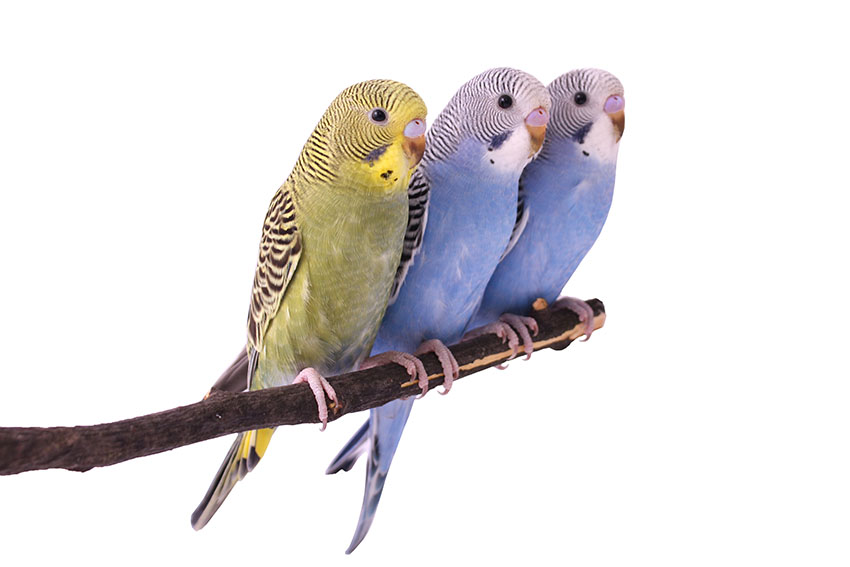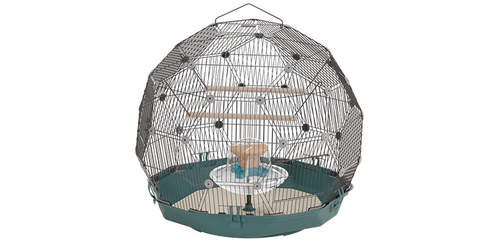Budgies need perches for sleeping, singing, playing, courting and resting. They love flapping or climbing from one perch to another, and will spend much of the day with their four toes curled around a perch. So, it’s important to give them some good ones, just as you would carefully choose the best chairs and sofas when furniture shopping.
You should have at least two perches, even in a small cage, and they should be at different levels so that your budgie gets as much variety in their perching as possible.
Budgie Perch Size
If you have a sufficiently large cage, vary the perch sizes. As long as there’s room for the bird to sit comfortably, the perch is useable. You can buy custom-sized ones for your cage; but the best ones are simple thin branches. These can be trimmed to size and inserted horizontally across the cage bars – versatile, and free!
Budgie Perch Types
It is best to avoid a smooth, rounded perch. Give the budgie’s feet something interesting to play on – one made from twisted twigs is a good option, or simply a customised stick. The bird will love chewing at the wood, and the rough surface is good for gripping. Pet shops stock plastic perches in interesting shapes, which are certainly better than plain, rounded wooden ones; but the rough-and-ready stick is still the best bet.

Three young budgies test a natural wood perch out for size
When adapting a large twig or small stick for a perch, give it a good scrub first. It’s just good practice to make sure anything introduced into the cage is thoroughly clean. Don’t use a strong detergent – just plain water and a vegetable brush will suffice. Some owners clean their sticks in a very dilute bleach solution (100ml bleach to 2 litres water). If you do this, rinse the stick thoroughly afterwards. Pouring boiling water over the stick will kill any microbes, just to be on the safe side. Always make sure the perch is completely dry before introducing to the cage – in the absence of direct sunlight, 20 minutes in an oven at 90C (200F) will do the job. Giving it a blast in the oven will also ensure there is nothing left alive either outside or inside the wood. Just make sure it’s cooled off before sticking it in the cage!
Over time a twig-perch will need to be replaced (usually because the budgie has chewed his way through it). When you introduce a new one, don’t be surprised if your birds seem a little wary at first. It’s a great budgie irony that they like things to be changed around a bit, but often take time getting used to the change.




Comments
Sarah, 28 October 2019
Hi there, I am wondering if an "open-cage" concept is a housing strategy that works for budgies? What I mean by that, is whether budgies can safely be housed either without a cage and instead with an open structure that has perches, food, water...etc., or with panels of a cage take out so that the cage isn't full enclosed. I am wondering this, because I would like my rescue budgies to get more used to myself and my boyfriend. It has been approx. 4 months since we got them from a shelter and they still do not want to step up onto our fingers and run away when we put our hands in the cage. We do not have any children or any other pets, and the windows in the room they're kept in are not normally opened. Looking for advice, thanks!
Cynthia, 29 June 2019
What type of wood is safe to use as a perch?
Leanne, 16 June 2019
Agree with all above. This is my go-to site for all things budgie
David, 9 November 2018
Thank you for that information on perches. It seems common sense that the best place for them to perch is the same place they would in the wild. That, cannot be duplicated. Also, a quick shout out to Google for pointing me here. I would assume maple or oak branches would be fine.
Silvia, 7 October 2018
Best site ever . Thanks to you all .